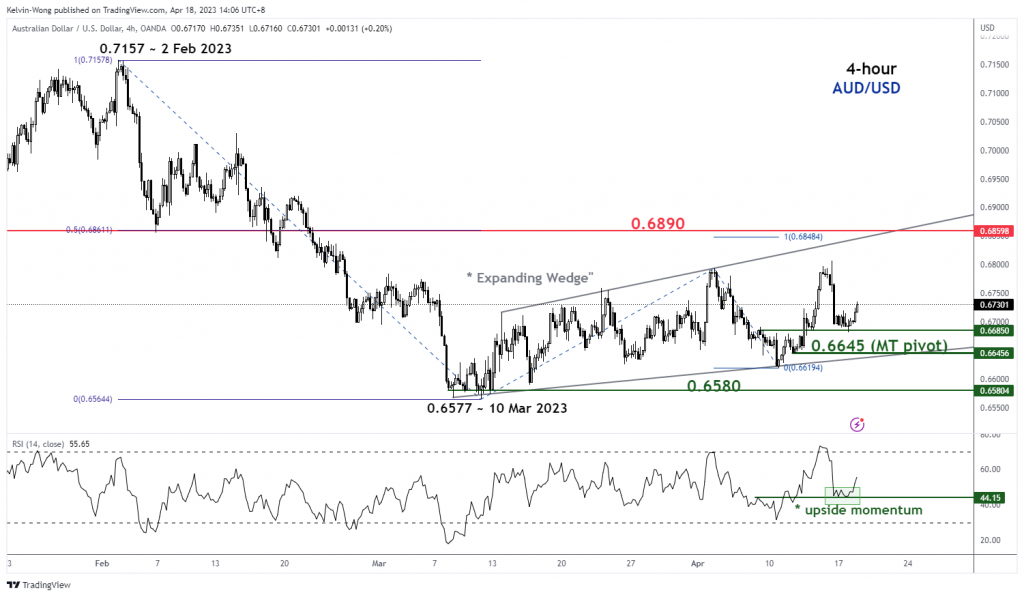- China’s Q1 GDP growth, retail sales, and industrial production continue to expand.
- Less aggressive monetary policy easing is needed from China’s central bank PBoC.
- AUD/USD short-term uptrend remains intact above 0.6645 key support.
The growth spurt from China reopening from its abandonment of stringent COVID-zero policy and implementation of stimulative policies late last year have continued to bear fruition. Today’s release of key China data indicates a robust internal economic environment coupled with its strong export growth for March that surged to an eight-month high of US$ 315.60 billion.
China’s key economic data continue to shine
China’s Q1 GDP growth grew at an annualized rate of 4.5%, accelerating from a 2.9% year-on-year growth recorded in Q4 22, above consensus estimates of 4%, its strongest pace of expansion since Q1 2022. Consumer spending continued to surge in March where growth in retail sales expanded to 10.6% year-on-year from 3.5% printed in February, beating estimates of 7.4%, its fastest growth rate since June 2021.
Industrial output continued to expand in March which recorded a higher growth of 3.9% year-on-year from a 2.4% rise recorded in the January to February combined period, the fastest expansion since October 2022 and almost on par with estimates of 4%. Meanwhile, the job market for China’s youth has remained lackluster, the youth urban jobless rate surged to 19.6% in March to hit a near-record high compared to the overall urban unemployed rate falling to 5.3% in March from 5.6% in February.
China’s central bank, PBoC is not in a panic mode to increase monetary policy easing
Given this latest set of robust economic data coupled with a rebound in new home prices in March that recorded its fastest pace of recovery in 21 months on a month-on-month basis; a 0.5% increase in March from a 0.3% rise in February, China central bank, PBoC is likely in no hurry mode to further loosen its liquidity taps to drive and stimulate economic growth at this juncture.
The latest monetary policy action of PBoC has shown evidence of such a “controlled accommodating” stance where it has left the key one-year medium-term lending facility interest rate (MLF) that is PBoC’s lending rate to big commercial banks unchanged yesterday at 2.75% for the fifth consecutive month. In addition, it injected the least amount of medium-term cash into the banking system; a 20-billion-yuan net injection via the MLF facility in April, the smallest amount since November 2022.
Therefore, it is not surprising to see China-related benchmarks and stock indices underperform their regional peers today as profit-taking activities took shape on prior session gains as such solid economic data has been priced and the lack of monetary policy easing aggressiveness from PBoC. At this time of writing, the Hang Seng Index and Hang Seng China Enterprise Index declined by around -0.70%.
In the foreign exchange space, the Aussie dollar tends to have a positive correlation with China’s growth given its close international trade linkage. Let’s look at the AUD/USD from a technical analysis perspective.
AUD/USD Technical Analysis – short-term uptrend intact within the “Expanding Wedge”
Source: TradingView as of 18 Apr 2023 (click to enlarge chart)
Since its 10 March 2023 low of 0.6577, the movement of AUD/USD has evolved into a short-term “Expanding Wedge” corrective rebound configuration as it sought to play out the retracement of its prior short-term downtrend of 592 pips from the 2 February high to 10 March 2023 low.
The short-term uptrend within the “Expanding Wedge” remains intact supported by a revival of short-term upside momentum as depicted on the 4-hour RSI oscillator as it staged a rebound from its corresponding support at the 44% level and has yet to reach its overbought level of more than 70%.
If the 0.6645 key medium-term pivotal support holds (also the lower boundary of the “Expanding Wedge”, the AUD/USD may see a push-up toward the next intermediate resistance at 0.6890 that confluences with the upper boundary of the “Expanding Wedge” and a Fibonacci extension/retracement cluster.
On the other hand, a break with a 4-hour close below 0.6645 invalidates the bullish tone for a continuation of the downtrend movement to retest the 10 March 2023 swing low area of 0.6580 in the first step.
Content is for general information purposes only. It is not investment advice or a solution to buy or sell securities. Opinions are the authors; not necessarily that of OANDA Business Information & Services, Inc. or any of its affiliates, subsidiaries, officers or directors. If you would like to reproduce or redistribute any of the content found on MarketPulse, an award winning forex, commodities and global indices analysis and news site service produced by OANDA Business Information & Services, Inc., please access the RSS feed or contact us at info@marketpulse.com. Visit https://www.marketpulse.com/ to find out more about the beat of the global markets. © 2023 OANDA Business Information & Services Inc.


